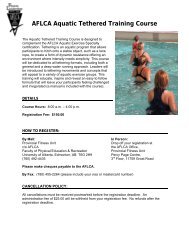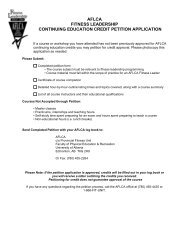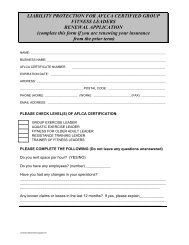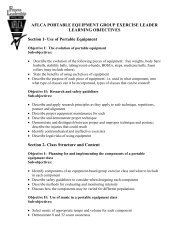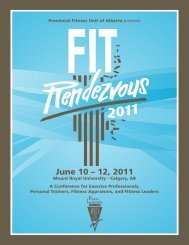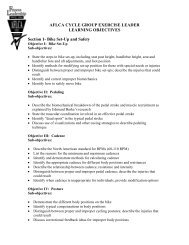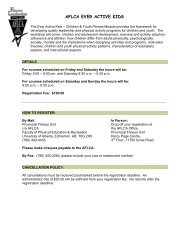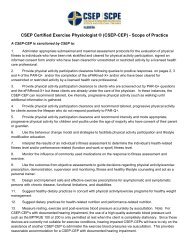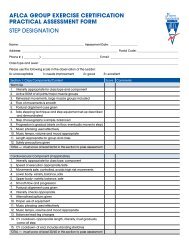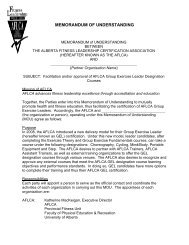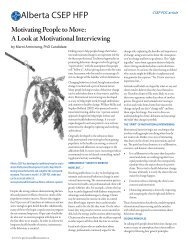AFLCA Resistance Training Study Questions 1. - Provincial Fitness ...
AFLCA Resistance Training Study Questions 1. - Provincial Fitness ...
AFLCA Resistance Training Study Questions 1. - Provincial Fitness ...
You also want an ePaper? Increase the reach of your titles
YUMPU automatically turns print PDFs into web optimized ePapers that Google loves.
<strong>AFLCA</strong> <strong>Resistance</strong> <strong>Training</strong> <strong>Study</strong> <strong>Questions</strong><br />
<strong>1.</strong> What is the definition of flexion?<br />
a. when a joint angle increases<br />
b. when a limb moves away from the midline of the body<br />
c. when a joint angle decreases<br />
d. when a limb moves towards the midline of the body<br />
2. What is another term for a concentric contraction?<br />
a. positive<br />
b. static<br />
c. negative<br />
d. neutral<br />
3. By training with the same duration and intensity it is possible to reduce the<br />
training frequency by _______ and still maintain the training effect.<br />
a. 1/2<br />
b. 2/3<br />
c. 1/3<br />
d. 2<br />
4. How can the force of an eccentric contraction be described?<br />
a. the strongest type of contraction<br />
b. stronger than an isometric contraction, but weaker than a concentric<br />
contraction<br />
c. the weakest type of contraction<br />
d. stronger than a concentric contraction, but weaker than an isometric<br />
contraction<br />
5. What is true about compound exercises?<br />
a. focus on just one set of muscles<br />
b. involves the movement of more than one joint<br />
c. reduces muscle coordination<br />
d. are ineffective in developing whole body movement<br />
6. Androgenic functions of testosterone do not include ......<br />
a. development of facial hair<br />
b. maintenance of muscle tissue<br />
c. maintenance of a deep voice<br />
d. distribution and amount of body fat
7. What two exercises in a super set would work the agonist and antagonist?<br />
a. seated row and lat pulldown<br />
b. bench press and lat pulldown<br />
c. bench press and fly<br />
d. squat and leg extension<br />
8. In the seated leg extension which muscle are being used?<br />
a. bicep fermoris, vastus intermedius, vastus lateralis, vastus medialus<br />
b. semitendinosus, vastus medialus, rectus femoris, vasuts lateralis<br />
c. semimembranosus, rectus femoris, vastus lateralis, vastus intermedius<br />
d. vastus intermedius, rectus femoris, vastus lateralis, vastus medialus<br />
9. What are three key elements involved in developing a strength program?<br />
a. workout variables, progression variables and administrative concerns<br />
b. warm-up, cool-down and workout phases<br />
c. progressive overload, choice of exercise and activity screening<br />
d. equipment available, exercise choices and order of exercises<br />
10. A needs analysis includes what components?<br />
a. collecting client information; health, fitness and activity information<br />
b. exercise movements, metabolic system used, injury prevention<br />
c. interpreting the information gathered<br />
d. developing an initial six week program<br />
1<strong>1.</strong> During an eccentric contraction what occurs in the agonist muscle fibre?<br />
a. muscle fibre shortens while exerting tension and force<br />
b. muscle fibre does not change in length while exerting tension and force<br />
c. muscle fibre lengthens while exerting tension and force<br />
d. muscle fibre shortens and lengthens while exerting tension and force<br />
12. Uncontrollable factors affecting strength include:<br />
a. height, weight, girth, percent body fat<br />
b. genetics, sex, age<br />
c. V02 max, heart rate, blood pressure, vital capacity<br />
d. protein supplements, blood sugar level, muscle glycogen storage<br />
13. <strong>Resistance</strong> training exercises for the muscle groups of the back include:<br />
a. one arm bent over row, seated pulley rows, shrugs<br />
b. concentration curls, bench press, crunches<br />
c. lunges, bicep curls, behind the neck press<br />
d. inclined bench press, lateral raises, one arm bent over row
14. Which primary mover does NOT corresponds with its movement action?<br />
a. latissimus dorsi extension<br />
b. trapezius adduction<br />
c. pectoralis major horizontal adduction<br />
d. anterior deltiod flexion<br />
15. An example of an isolation exercise is:<br />
a. tricep pushdown<br />
b. lat pulldown<br />
c. flat bench press<br />
d. behind the neck press<br />
Answers: 1 – c, 2 – a, 3 – c, 4 – a, 5 – b, 6 – b, 7 – b, 8 – d, 9 – a, 10 – b, 11 – c, 12 – b,<br />
13 – a, 14 – b, 15 – a.



